
11/6,62),7,9(7516,7,216,17+(&//
OFTHEWILD"BYJACKLONDONANDTHEVIETNAMESE
(48,9/(176,1,767516/7,219(56,21
7DQ7KLHQ
(PDLOWDQOHQKRHQ
Received:05/08/2024
Revised:17/02/2025
Accepted:26/02/2025
DOI:10.59266/houjs.2025.540
EVWDFWThisstudyaimstoexploretheuseofadditivetransitionsinTheCallofthe
WildbyJackLondonandtheirVietnameseequivalents.Theresearchintendstoassistboth
HGDWRVDQGHDQHVLQDGGHVVLQKDHQHVHDWHGWRWDQVDWLQLQLQRGVRP
EnglishtoVietnamese.Thetransitionsareanalyzedthroughthetheoreticalframeworksof
HallidayandHassan(1976)andNguyenHongCon’s(2005)translationmethod.Thestudy
primarilyemploysqualitative,quantitative,anddescriptiveapproaches.Dataisgathered
on additive transitions along with two translation methods: word-for-word and addition.
Theanalysiscovers22additivetransitionsused1,555timesinJackLondon’snovel,with
translatorHoangHaVurendering09ofthesethroughomission.Thendingsareintended
toaidbothlecturersandstudentsinmasteringthemeaningsoftransitionsinEnglishand
exploringstrategiesfortranslatingtransitionwordsinliterarytexts.
.HRV:additivetransitions,Vietnameseequivalents,translationversion,literature,novel.
HanoiOpenUniversity
,,QWURGFWLRQ
In the age of globalization,
VRFLDO FKDQJ DQ LQJUDLRQ DU
rapidly occurring worldwide, with
OLUDU DQ SRU SODLQJ D N URO
in connecting societies. Translation
is vital in overcoming linguistic and
FOUDO EDUULUV DQ RVULQJ PDO
understanding across communities. This
connection,transcendingtimeandspace,
KLJKOLJKV K LPSRUDQF R UDQVODLRQ
and equivalence, which has become a
signicant topic in modern linguistics,
SDULFODUO LQ (QJOLVK FDLRQ LQ
Vietnam,suchasattheFacultyofEnglish
–HanoiOpenUniversity.Onerenowned
literarywork,KH&DRWKH:LGE-DFN
London,remainspopularnotonlybecause
RLVSOREDOVRRULVUPDUNDEOV
of language. A standout feature is the
eectiveuse of connective words,which
are essential in expressing ideas clearly,
concisely, and coherently. These words
SOD D FUFLDO URO LQ PDNLQJ FRPSO

ideasaccessibleandenhancingtheoverall
readabilityofthenovel.
Theresearchndingsoftheproject
can become valuable reference materials
forresearchersandindividualsinterested
intheeldoftranslation.Theycanserve
DV UUQF RFPQV RU DFKLQJ DQ
ODUQLQJ UDQVODLRQ VEFV DQ PRUQ
English language studies. The research
questions,therefore,areposedasfollows:
What are the semantic and syntactic
features of transitions in the novel
KH &D R WKH :LG by Jack London?
What techniques does Hoang Ha Vu
V R UDQVOD (QJOLVK UDQVLLRQV LQR
Vietnamese transitions in the novel KH
&DRWKH:LGbyJackLondon?
,,7HRUHWLFDOEDFNJURQG
7DQVODWLRQ
Within the eld of interpretation,
Ghazala(2014)underscoresinterpretation
as an expertise comprising dierent sub-
skills, such as dialect capability, content
comprehension, and assistant aptitudes.
Lefevere(1992,2004b)seesinterpretation
as preparation for modifying, aected
E ERK FRQFSDOLDLRQ DQ VFKRODUO
strategies. Bassnett and Lefevere (1998)
emphasize the signicance of culture
in interpretation, recognizing its part
LQ QFRUDJLQJ ERK PRORJLFDO DQ
intercultural communication. Gentzler
(2008) contends that interpretation goes
past insignicant etymological transfer,
LQFRUSRUDLQJ VRFLDO DVSFV KD LOO
anticipate the complete conservation of
thersttext’smagnicenceandmeaning.
Benjamin (1923) presents the idea of
LQUSUDLRQ DV D SRULRQ R K V
great beyond. From a phonetic point of
view,researcherslikeNida(1964,2004),
Newmark (2001), and Catford (1965)
classify interpretation based on extent,
levels,andpositions,displayingstrategies
suchasword-for-word,exacting,andfree
interpretation.
Buildingontherenementbetween
two sorts of interpretation units, words
and sentences. Nguyen (2005) proposes
a classicationstrategy forinterpretation
strategies, isolating them into word
LQUSUDLRQ VUDJLV DQ VQQF
interpretation strategies. To oversee and
V S LQUSUDLRQ FRPSDUDELOL DK
sentence level, interpreters can utilize
dierent methods, a few of which are
VNFKREOR
Word-for-word translation: 7KLV
least dicult strategy sets up syntactic
SURSRULRQDOLELQUSULQJDFKRU
URP K VRUF LDOF LQR K DUJ
LDOFDFFRULQJRDVUDLJKDUUDQJPQ
(fromlefttoright).
&KDQLQRGRGH7KLVPKR
DUVVV UURUV LQ RU RUU KQ
UDQVODLQJ D VQQF URP K VRUF
dialect to the target dialect,guaranteeing
the target sentence is linguistically,
semantically,orlogicallysuitable.
GGLQ R RPLWWLQ RGV 7KLV
procedure includes either overlookingor
including words to abbreviate or extend
K VQQF VUFU KQ FLSKULQJ
fromthesourcetothetargetdialect.
SLWWLQ R PHLQ VWWHV
According to this method, a sentence
URPKVRUFLDOFPDEFLSKU
LQRQPURVVQQFVLKLQKDUJ
dialect (splitting), or dierent sentences
LKLQKDUJODQJDJPDEEOQ
LQR RQ VQQF LKLQ K VRUF
language, depending on the needto pass
onmeaningorfashion.
WWD WDQVRPDWLRQ Given
the basic contrasts between dialects,

interpreters mayhaveto utilizeauxiliary
change methods. Thisinvolvesreplacing
the initial structure with an elective
VUFU LKLQ K DUJ LDOF R
guaranteecommoninterpretation.
Idiomatic translation: 7KLV
SURFU FKDQJV D VQQF URP
K VRUF LDOF LQR DQ LLRPDLF RU
LLRPDLFOLNSUVVLRQLKLQKDUJ
dialect, frequently utilized to interpret
FROORTLDO VQQFV LQR FRPSDUDEO
expressionswithinthetargetdialect.
LWLHWDQVLWLRQV
HallidayandHasan(1976b)clarify
that moves are words or expressions
utilized to put through thoughts, making
adierenceinreadersmovingeasilyfrom
onenoteworthythoughttothefollowing.
GGLWLH WDQVLWLRQV move present, extra
data, likenesses,orreferences,extending
thoughtsandadvertisingadvancedsubtle
elements or distinctive points of view.
Theyguaranteeasmoothstreamofdata,
permittingamoreprofoundinvestigation
fromdierentangles.
,,,0HWRGRORJ
7K DSSURDFK LV K VOFLRQ R D
placetolookatthesubject,awaytolookat
theobjectofstudy.Inthisresearchpaper,
KROORLQJLQRUPDLRQDSSURDFKVLOO
EV
6UFU 6VPV QDOVLV
VVPDLF DSSURDFK LV DODV LJK
and logical.A system always consists of
elementsthataredividedintohierarchies,
characterized by relative, relative but
interactive,goalsthatrepresenttheoverall
goal. In this study, there are 54 additive
transitionslisted.
7K LQRUPDLRQ FROOF PV
always exist in two qualitative and
quantitative forms. In addition, the
subjectofthesurveyshouldbeconsidered
from both qualitative and quantitative
perspectives. In certain cases, access to
quantitative information is not possible.
Therefore, the qualitative information
DSSURDFK LV K RQO SRVVLEO PKR
in this study. By listing the additive
transitions in “The Call of the Wild” by
JackLondon,thedataforthenalgoalis
tobeawareofthequalitativenatureofthe
subject.
,9)LQGLQJDQGGLVFVVLRQ
7KHFKDDFWHLVWLFVRIQWDFWLF
IQFWLRQV
InEnglish,additivetransitionsexist
intwoshapes.Theseareconjunctionsthat
JDUDQVQDFLFRUNLKRUTLULQJ
anyothercomplementarycomponents.
7KSULPDUUDPLVVUDLJKRUDU
conjunctions.Inthisshape,theword‘and’
VKRVSDKVDURKVQQF
LPVDQLKLQKFQURKVQQF
1427 times. The word ‘like’ shows up
LKLQKFQURKVQQFLPV
andatthestart5times.Thewords‘thus’
and ‘besides’ both appear within the
sentence’scenter4times.
7K VFRQ VKDS LV FRPSRQ
conjunctions, with 12 complex
conjunctions. The expression ‘neither ...
QRU VKRV S LKLQ K FQU R K
sentence10times.‘Either...or’and‘such
DVDFKVKRSLKLQKFQURK
sentence3times,while‘infact’showsup
at the start of the sentence 4 times. The
state‘notasitwere...but’showsupboth
D K VDU DQ LKLQ K PLO R K
sentence. The remaining words show up
once.
Hence, basic conjunctions, which
have a place in the gathering of added
substanceconnectingwords,areutilized

LPV LKLQ K FQU R K
sentence and 154 times at the start. In
the interim, compound conjunctions
VKRSLPVLKLQKFQURK
sentence and 9 times at the beginning.
8QUQDK PD E D QL JUL DEO
RKVQDFLFRUNRDVEVDQF
connectingwords.
Table1:Syntacticfunctionsofadditivetransitions
3DUWRI
6SHHF
&RRUGLQDWLQJ
&RQMQFWLRQV
WWH
EHJLQQLQJ
,QWH
PLGGOH
&RUUHODWLYH
&RQMQFWLRQV
WWH
EHJLQQLQJ
,QWH
PLGGOH
Additive
UDQVLLRQV
1.and 1.either…or
2.beside(s) 2.neither…nor
3.indeed 3.notonly...but
4.further 4.aswell
5.including 5.inadditiontothis
6.like 6.infact
7.especially 7.ontheotherhand
8.considering 8.suchas
9.concerning 9.inparticular
10.thus 10.forinstance
11.asfor
12.thefactthat
7RWDO
KDDFWHLVWLFV RI HPDQWLF
IQFWLRQV
7KDEOQUQDKVKRVKDK
DVEVDQFFRQQFLQJRUV
substance)areisolatedintofourbunches:
expansion, presentation, reference, and
distinguishing proof. Among them, the
conjunction “and” is utilized as often
as possible, showing up 1,555 times
within the work. When deciphered into
Vietnamese, this conjunction holds its
meaning (và) 245 times, is decoded
with a diverse meaning 177 times, and
isn’t deciphered 195 times. Themoment
PRV RQ LOL FRQQFLRQ LKLQ
the workis“like,”showing up69 times,
DQ L LV QDUO FRQLQRVO KO LQ LV
QLT PDQLQJ KQ LQUSU LQR
Vietnamese. The remaining conjunctions
DU LOL OVV UJODUO DQ KRO KLU
meaningwheninterpretedinVietnamese.
Table2:Semanticfunctionsofadditivetransitions
3DUW,6HPDQWLF
IQFWLRQV 1R GGLWLYH
WUDQVLWLRQV
7RWDO
IUHTHQF
0DLQWDLQLQJ
WHPHDQLQJ
&DQJLQJ
WHPHDQLQJ
1R
WUDQVODWLRQ
GGLWLRQ
DQ
either…or
neither…nor
notonly...but
DVOO
LQDLLRQRKLV
beside(s)
LQ
UKU
LQDF
RQKRKUKDQ

3DUW,6HPDQWLF
IQFWLRQV 1R GGLWLYH
WUDQVLWLRQV
7RWDO
IUHTHQF
0DLQWDLQLQJ
WHPHDQLQJ
&DQJLQJ
WHPHDQLQJ
1R
WUDQVODWLRQ
,QWURGFWLRQ
VFKDV
LQFOLQJ
OLN
LQSDULFODU
RULQVDQF
VSFLDOO
5HIHUHQFH
FRQVLULQJ
DVRU
FRQFUQLQJ
KDFKD
Identication KV
7RWDO
KDDFWHLVWLFV RI 3DPDWLF
IQFWLRQV
Theinterpreter,HoangHaVu,when
FLSKULQJ(QJOLVKVQQFVFRQDLQLQJ
connectingwordsintoVietnamese,makes
FUDLQFKDQJVRKVQQFVUFU
&KDQLQ WKH PHDQLQ R
DGGLWLHWDQVLWLRQV
Q (QJOLVK VQQF FRQDLQLQJ
additive transitions was interpreted into
two or three sentences in Vietnamese,
with the connecting words having their
implications changed. In the case of
added substance connecting words, the
interpreter used “and” to interpret the
work. According to measurements, 39
(QJOLVK VQQFV U FKDQJ E K
LQUSUUURPDVLQJO(QJOLVKVQQF
intotwoorthreeVietnamesesentences.
Example1:Ontheotherhand,there
werethefoxterriers,ascoreofthematleast,
KROSDUOSURPLVVD7RRVDQ
Ysabel,lookingoutofthewindowsatthem
DQ SURF E D OJLRQ R KRVPDLV
DUPLKEURRPVDQmops.
(lines9-11,page4,chapter1)
(Ngoira cònc bọn ch sục co
na, ít nhất cũng phải hai chục con.
Chúng thường sa nhặng ln dọa Toots
vớiYsabellúchaiconnynhòmrangoi
cửa,vmtbinhđonhầugivũtrang
bichổiFQcylau.)
Example2:Hehadneverseendogs
ght as these wolsh creatures fought,
DQ his rst experience taught him an
unforgettablelesson.
LQHSDHKDSWH
(Buckcũngchưabaogiờchứngkiến
đồngloạimnhcnxénhauhunghãnnhư
đấy.Thếnên,ngaylầnđầutintnmt
quanst,nlptứccngaychomnhmt
bihọcnhớđời.
4.3.2.Omittingadditivetransitions
URPDQ(QJOLVKVQQFFRQDLQLQJ
additive transitions, when deciphered
into Vietnamese, it was rendered as 2
RU VQQFV LK K FOVLRQ R K
additivetransitions.
Withinthecaseofaddedsubstance
additivetransitions,48Englishsentences
LKLQKRUNUFLSKULKR
theadditivetransitionscarryingovertheir
meaning into Vietnamese.Among them,
“and”accountsfor44sentences;“neither...
nor” for one sentence; “encourage” for
onesentence;“suchas”foronesentence;
and“like”foronesentence.
Example 1: He could eatanything,
nomatterhowloathsomeorindigestible,
DQGonceeaten,thejuicesofhisstomach


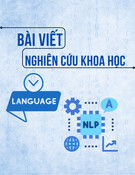





![Phương pháp dóng hàng câu tự động cho văn bản Trung Quốc cổ điển - Việt Nam hiện đại [chuẩn SEO]](https://cdn.tailieu.vn/images/document/thumbnail/2025/20250715/nomoney11/135x160/99021752553566.jpg)
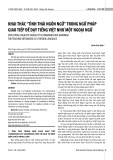
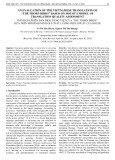
![Bộ câu hỏi trắc nghiệm Văn bản tiếng Việt [chuẩn nhất]](https://cdn.tailieu.vn/images/document/thumbnail/2025/20251127/thuynhung051106@gmail.com/135x160/24021764296609.jpg)


![Bài giảng Ngôn ngữ học đối chiếu Nguyễn Ngọc Chinh [PDF]](https://cdn.tailieu.vn/images/document/thumbnail/2025/20251101/vovu03/135x160/7471762139652.jpg)





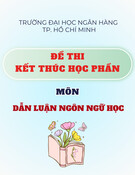
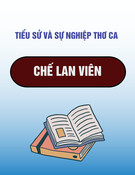
![Ngân hàng câu hỏi môn Tiếng Việt thực hành [chuẩn nhất]](https://cdn.tailieu.vn/images/document/thumbnail/2025/20251003/kimphuong1001/135x160/21861759464951.jpg)
![Bài giảng Văn học phương Tây và Mỹ Latinh [Tập hợp]](https://cdn.tailieu.vn/images/document/thumbnail/2025/20251003/kimphuong1001/135x160/31341759476045.jpg)


